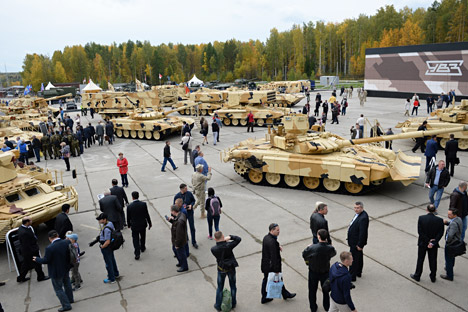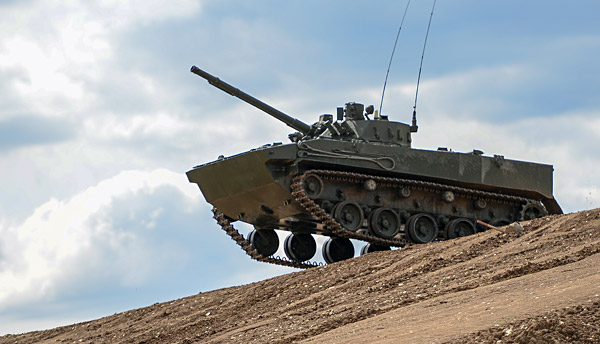
Participants in the 10th Russia Arms Expo international exhibition look at the combat vehicles displayed. Source: Pavel Lisitsyn / RIA Novosti
Pavel Lisitsyn/RIA NovostiAccording to the expo's organizers, in three days the event was visited by 50,000 people from 65 countries, including Turkey, South Korea, France and Jordan.
During the expo Russia signed a contract with India on the supply of spare parts for T-72 tanks, as well as for participating in the modernization program of the Indian army's BMP-2 fleet. Moreover, a number of Middle Eastern countries are interested in acquiring modernization systems for the T-72 tanks that would transform them into combat support vehicles for the BMPT-72 tanks. The T-72 tanks are already present in the Iraqi, Iranian, Syrian and Yemeni armies.
For the first time foreign guests could see the new T-14 and BMP T-15 tanks on the Armata platform up close. According to Russian Deputy Prime Minister Dmitry Rogozin, Russia is counting on the substantial export of armored vehicles on this platform.
The Traktorniye Zavody Concern showed its new Derivatsiya and Dragun combat vehicles that are based on the BMP-3. The Derivatsiya and Dragun have a new remotely controlled combat module, which is supplied with the AU-220M 57-mm automatic cannon and the 2A70 100-mm cannon, respectively.

The BMP-3 infantry fighting vehicle. Source: Alexander Vilf / RIA Novosti
Another novelty was the BMP drone. It is the same BMP-3, only with the new Vityaz system. With the Vityaz the BMP is capable of being controlled at a distance and waging network-centric wars without a crew.
Myanmar and Morocco have applied to acquire a BMP-3 basic version.
The main topic of discussion during the event was the role of Russia's military-industrial complex against the backdrop of Western sanctions. The participants concluded that even though the sanctions had animated the country's defense industry, Russia should not isolate itself with import substitution. It is necessary to cooperate with other countries, in particular with the South Asian region, in order to reduce costs at the production level and increase its competitiveness on the world market.
Many discussions were dedicated to the branding of Russia's military production. According to several participants, a brand in the defense industry is not only a marketing element but also an element of soft power. This is why substantial attention will be devoted to the branding of military production.
Effective, reliable, simple to use and undemanding in service were said to be the main traits of Russia weapons, and they will be emphasized in the promotion of Russian technology abroad.
All rights reserved by Rossiyskaya Gazeta.
Subscribe
to our newsletter!
Get the week's best stories straight to your inbox